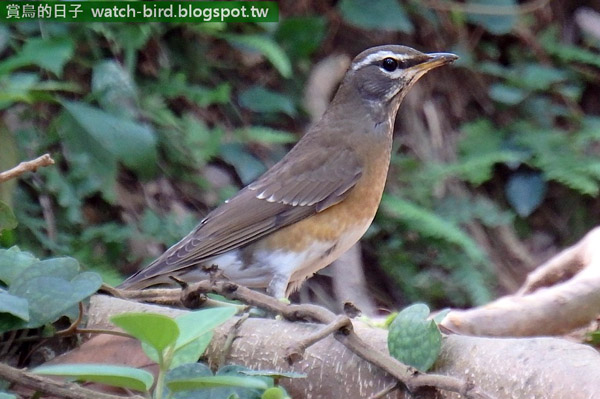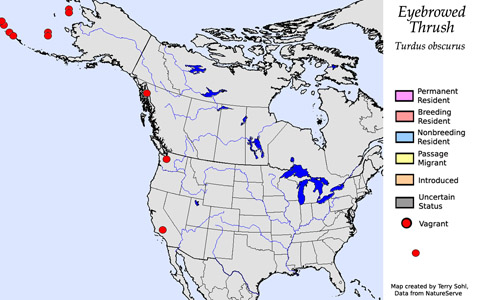| Length: 8.5 inches | Wingspan: 12.5 inches | Seasonality: Non-resident in South Dakota |
| ID Keys: Gray upperparts and head, white eyebrow and chin, orangish flanks and breast, white belly | ||
 The
Eyebrowed Thrush is an Asian thrush species, normally found in Siberia in
the summer and southeastern Asia in the winter. They have become
rather regular spring visitors to the western Aleutian islands of Alaska, as
well as the islands of the Bering Sea. Even more rare in North America
are the handful of sightings on the mainland, with sightings in eastern
(coastal) Alaska, Washington state, and California. They have also been seen
as a vagrant in parts of Europe.
The
Eyebrowed Thrush is an Asian thrush species, normally found in Siberia in
the summer and southeastern Asia in the winter. They have become
rather regular spring visitors to the western Aleutian islands of Alaska, as
well as the islands of the Bering Sea. Even more rare in North America
are the handful of sightings on the mainland, with sightings in eastern
(coastal) Alaska, Washington state, and California. They have also been seen
as a vagrant in parts of Europe.
Habitat: Found in boreal forest and taiga during the summer breeding months.
Diet: Feeds on earthworms, insects, other small invertebrates, fruits, and berries.
Behavior: Much of the foraging of an Eyebrowed Thrush occurs on the ground, with a bird hopping and periodically stopping as it searches for food. They will also clamber through vegetation at times to glean insects, or foraging in the forest canopy or undergrowth for fruits and berries.
Nesting: The nest of an Eyebrowed Thrush is a cup, constructed of grasses, twigs, moss, strips of bark, and other material, placed in a tree from 4 to 20 feet high. The female lays between 3 and 6 eggs, and she alone incubates them. The young hatch after about 2 weeks.
Song: The song is a series of whistled phrases with interspersed harsher notes.
Migration: Strongly migratory. During the summer breeding season, Eyebrowed Thrush are found in Siberia and northern China. During the winter months, they are found in Indonesia and other parts of southeastern Asia.
Feeders: Will sometimes attend feeders for offered fruits, berries, and nuts.
Interactive eBird map: Click here to access an interactive eBird map of Eyebrowed Thrush sightings
Similar Species: Very similar to American Robin. They are generally duller and less "bright", and the darker throat is another featured which distinguishes the Eyebrowed Thrush. The obvious supercillium is an obvious plumage feature, yet some possible records of Eyebrowed Thrush in the U.S. have been dismissed as possible "atypical" American Robins. A western race of American Robins may sometimes have a pale looking supercillium. Another rare Asian vagrant, the Dusky Thrush, may also be potentially confused with the Eyebrowed Thrush due to the strong eyebrow pattern on both species. They could also be confused with Redwing, a Eurasian species that is a rare vagrant in North America.
Conservation Status: Populations of Eyebrowed Thrush aren't well understood, but they are found over a relatively broad geographic area and are present in sufficient numbers to preclude any evidence of an imminent threat to the species. The IUCN lists the Eyebrowed Thrush as a species of "Least Concern".
Further Information: 1) BirdLife International - Eyebrowed Thrush
2) WhatBird - Eyebrowed Thrush
3) Eyebrowed Thrush vs. American Robin
Photo Information: Photo taken for watch-bird.blogspot.tw - Photo licensed under Creative Commons Attribution ShareAlike 2.0 Generic License.
| Click below for a higher-resolution map |
 |
| South Dakota Status: Non-resident in South Dakota |
Additional Eyebrowed Thrush Photos (coming soon!!)
